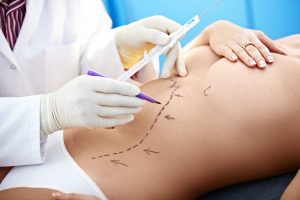Tummy tuck surgery, also known as abdominoplasty, removes excess fat and skin from the middle and lower abdomen and, in most cases, restores weakened or separated muscles creating an abdominal profile that is smoother and firmer.
What causes a sagging Abdomen ?
- Aging
- Heredity
- Pregnancy
- Prior surgery
- Significant fluctuations in weight
What tummy tuck surgery can’t do?
A tummy tuck is not a substitute for weight loss or an appropriate exercise program.
Although the results of a tummy tuck are technically permanent, the positive outcome can be greatly diminished by significant fluctuations in your weight. For this reason, individuals who are planning substantial weight loss or women who may be considering future pregnancies would be advised to postpone a tummy tuck.
A tummy tuck cannot correct stretch marks, although these may be removed or somewhat improved if they are located on the areas of excess skin that will be excised.
What are the different types of Tummy Tuck Procedures?
a complete (or full) abdominoplasty
Partial (or mini) abdominoplasty
Extended abdominoplasty
An extended abdominoplasty is a complete abdominoplasty plus a lateral thigh lift. It allows further improvement of the flank (waist), as well as smoothing the contour of the upper lateral thigh.
High lateral tension tummy tuck
Conventional abdominoplasty tightens muscles in a vertical line. In this new method, known as high lateral tension abdominoplasty, in addition to vertical-line tightening, muscles are tightened horizontally. The final result with this technique is a dramatically flat abdomen with significantly better-defined waistline.
Floating Abdominoplasty or FAB Technique
also known as an extended mini abdominoplasty, allows for tightening and shaping through a smaller incision excess skin is removed and the belly button is temporarily detached. The muscles are tightened and reshaped. The skin is then tightened and the belly button is reattached, or moved down one or two cm if desired
Circumferential abdominoplasty
A circumferential abdominoplasty is an extended abdominoplasty plus a buttock lift. The resulting scar runs all the way around the body, and the operation is also called a Belt Lipectomy or lower body lift. This operation is most appropriate for patients who have undergone massive weight loss.
Combination procedures
An abdominoplasty can be combined with liposuction to make a Lipotuck, which performs body contouring around the hips, thighs, and buttocks.
A popular name for breast enhancement procedures performed in conjunction with an abdominoplasty is a “mommy makeover”.
What is expected in the Recovery period ?
- Depends on the problem treated, surgical technique(s), and other factors, it Can take one to four weeks and patients are advised to take at least a portion of this recovery time off from work.
- Heavy lifting is best avoided during this time.
- Initially there may be bruising and discomfort.
- A supportive abdominal binder or compression garment can minimize swelling / bruising, and support the repaired tissues. This compression garment is also effective in helping the skin in the treated area conform to its new shape.
- Patients are advised to avoid all forms of nicotine for a month or longer prior to surgery and also during the recovery period.
- Full recovery takes 3–6 months, with further fading of scars thereafter. Scars may appear red and prominent at first, but with proper care, they heal into a thin, silvery line.
What are the Risks of Tummy Tuck ?
1.Infection and blood clots are a serious potential risk after abdominoplasty, but which occur rarely.Patients are recommended to move around as soon as possible after surgery to minimize their risks. Pulmonary embolism, heart attack or stroke are very rare complications that may result after any type of surgery due to immobility
2.Skin necrosis, Fatty tissue found deep in the skin might die (fat necrosis),Major wound separation,
These are some of the complications that may require another procedure as the dead skin must be replaced by a skin graft. Although necrosis is extremely rare, smokers have an increased risk to develop skin necrosis.
3.One of the more common problems after an abdominoplasty is collection of fluid under the skin after the drains have been removed. A surgeon can aspirate the fluid with a needle. The drainage stops within a month and does not affect the final results.
4.The scars resulting from abdominoplasty are long and permanent. Although this scar will never become invisible, it is usually placed under the swimsuit line so it is covered by clothes. It normally takes nine months to a year before scars flatten out and lighten in color.
5. Numbness or other changes in skin sensation, Asymmetry








